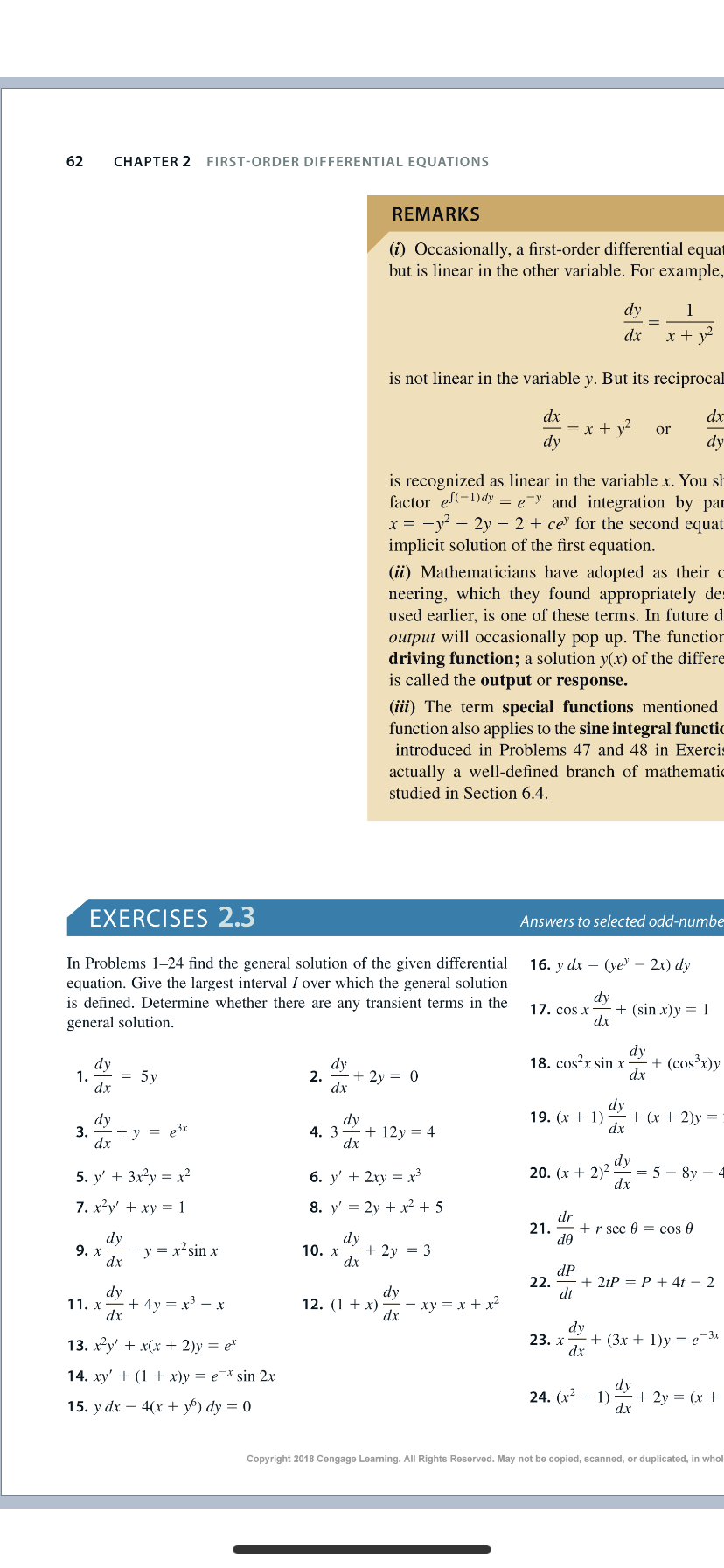62 CHAPTER 2 FIRST-ORDER DIFFERENTIAL EQUATIONS REMARKS (i) Occasionally, a first-order differential equat but is linear in the other variable. For example, dy x + y- dx is not linear in the variable y. But its reciprocal dx = x + y? dy dx or dy is recognized as linear in the variable x. You sh factor e-1)dy = e¯y and integration by par x = -y² – 2y – 2 + ce' for the second equat implicit solution of the first equation. (ii) Mathematicians have adopted as their o neering, which they found appropriately des used earlier, is one of these terms. In future d output will occasionally pop up. The functior driving function; a solution y(x) of the differe is called the output or response. (iii) The term special functions mentioned function also applies to the sine integral functic introduced in Problems 47 and 48 in Exercis actually a well-defined branch of mathematic studied in Section 6.4. EXERCISES 2.3 Answers to selected odd-numbe In Problems 1-24 find the general solution of the given differential equation. Give the largest interval I over which the general solution is defined. Determine whether there are any transient terms in the 16. y dx 3D (ye' — 2х) dy dy 17. cos x + (sin x)y = 1 dx general solution. dy + (cos?x)y dx 18. cos?x sin x dy dy = 5y + 2y = 0 2. 1. dx dx dy + (x + 2)y = dx 19. (x + 1) dy 3. + y = e3x dx dy + 12y = 4 dx 4. 3 ,dy = 5 - 8y dx 20. (х + 2)- 5. y' + 3x?у %3 х? 6. y' + 2xy = x³ 7. х*у' + ху %3D1 8. y' = 2y +x² + 5 dr + r sec 0 = cos 0 21. do dy 9. x y = x'sin x dx dy + 2y = 3 dx 10. x dP + 2tP = P + 4t – 2 22. dy dy dt - xy = x + x² dx + 4y = x3 – x 11. x 12. (1 + x) dx dy + (3x + 1)y = e-3x 23. x 13. x2y' + x(x + 2)y = e* dx 14. xy' + (1 + x)y = e¯* sin 2x 24. (х2 — 1) + 2y = (x + dx 15. y dx — 4(x + уб) dy %3D 0 Copyright 2018 Cengage Learning. All Rights Reserved. May not be copied, scanned, or duplicated, in whol
Compound Probability
Compound probability can be defined as the probability of the two events which are independent. It can be defined as the multiplication of the probability of two events that are not dependent.
Tree diagram
Probability theory is a branch of mathematics that deals with the subject of probability. Although there are many different concepts of probability, probability theory expresses the definition mathematically through a series of axioms. Usually, these axioms express probability in terms of a probability space, which assigns a measure with values ranging from 0 to 1 to a set of outcomes known as the sample space. An event is a subset of these outcomes that is described.
Conditional Probability
By definition, the term probability is expressed as a part of mathematics where the chance of an event that may either occur or not is evaluated and expressed in numerical terms. The range of the value within which probability can be expressed is between 0 and 1. The higher the chance of an event occurring, the closer is its value to be 1. If the probability of an event is 1, it means that the event will happen under all considered circumstances. Similarly, if the probability is exactly 0, then no matter the situation, the event will never occur.
#1 please

Trending now
This is a popular solution!
Step by step
Solved in 4 steps with 4 images









